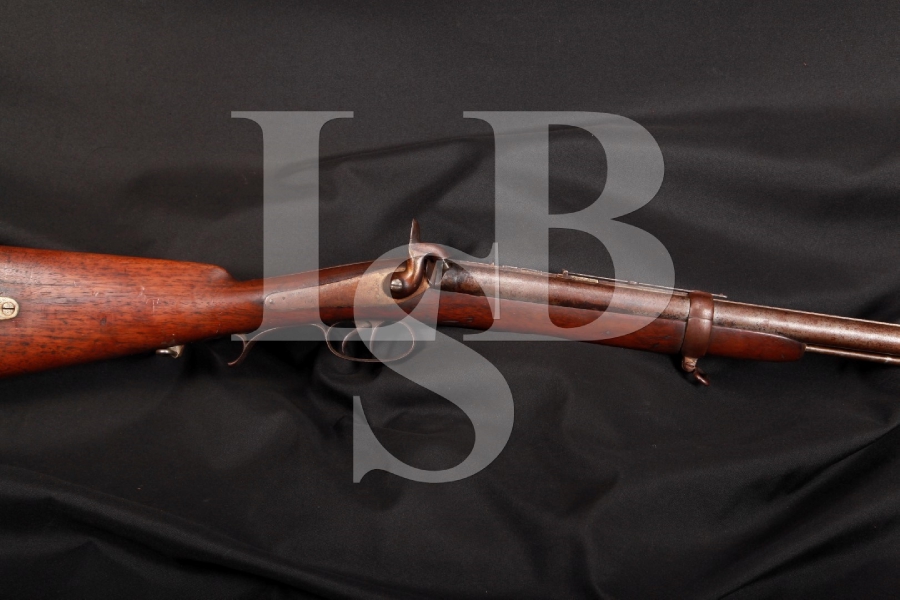
Jacob’s / Swinburn & Son Double Barrel Rifle Mfd 1861, Antique Shoots Exploding Projectiles 1,000 Yrd’s
LSB#: 130917XX05
Make: Swinburn & Son
Model: Jacob’s Double Rifle
Serial Number: NSN
Year of Manufacture: 1861
Caliber: 32 Bore (0.524 Caliber)
Action Type: Double Hammer, Double Trigger, Double Barrel Percussion Rifle
Markings: Both lock plates are marked “SWINBURN & SON / PATENT / 1861”. The left side of the barrel band is marked with a stylized “JS over 3” and what appears to be “PAT374”. The patchbox is marked “Jacob’s Rifles”. The stylized “JS over 3” is found on the folding sight leaf that is also marked “3”, the five inch folding ladder sight, the base of the ladder sight, the top tang, the inside of the patch box door and stamped in the wood between the end of the lower tang and the rear sling loop. The ladder sight is marked for 300 through 2000 yards and has “Vis” at the top. As mentioned, one folding leaf sight is marked “3” and the other remaining folding leaf sight is marked “2”.
Barrel Length: 24”
Sights / Optics: The front sight is a dovetail set beaded blade. The rear sight had three folding rear leafs, of which the ones marked “2” and “3” remain. There is also the 5” tall folding ladder sight with markings from 300 to 2000 yards. When the ladder sight is folded down a “V” shaped notch comes into view.
Stock Configuration & Condition: The one piece stock is smooth walnut with handling, compression marks and a few small gouges. The LOP measures 14 ¼” from the front of the forward trigger to the back of the metal buttplate. For a rifle manufactured as a military arm in 1861, the stock is in Very Good to Fine condition with no chips or cracks.
Type of Finish: Unknown
Finish Originality: None Remains
Bore Condition: The bores each have four lands and four grooves. There is rust in the bores, but the rifling remains visible and deep. There is some erosion.
Overall Condition: This rifle retains about 0% of its metal finish. The balance of the finish shows brown patina except on the barrels which have black freckling. The patchbox has some light lines of abrasion. The screw heads are surprisingly sharp. The forward lower tang screw is a little proud. The checkering on the hammers and the rear of the lower tang show wear. The markings on the lock plates are quite clear, if not deep. The other markings are lighter, with some of the stylized “JS over 3” stampings being partial conjecture. The end of the ramrod is currently an empty cup; originally it probably had a boxwood plug. Overall, this rifle rates in about Fine antique condition.
Mechanics: The action functions correctly. We have not fired this rifle.
Box, Paperwork & Accessories: None
Our Assessment: This Jacob’s Double Rifle appears complete with the exception of the number 1 folding rear leaf sight and the boxwood plug in the ramrod. We believe it was made without the bayonet lug. The history of the Jacob’s Double Rifles is quite interesting, and the history of Brigadier-General John Jacob (who designed the rifle) even more so. For history on both please see: http://www.myjacobfamily.com/articleskennethjacob/generaljacobarticle.htm. This double rifle was designed to shoot either lead bullets or exploding bullets at ranges possibly exceeding 1,000 yards. It is explained that at very long ranges involving the ladder sight, the rifle is fired from the shoulder from rest at long range, this being necessary to see over the 5” tall sight and to tolerate the recoil of a charge capable of hurling a projectile 1000s of yards. Though originally intended for use by the British and Indian armies in Afghanistan and Pakistan, some of these double rifles apparently saw service by both sides during the U.S. Civil War. This example is in Antique Fine overall condition, one of perhaps one thousand actually made from 1859 to 1862.

